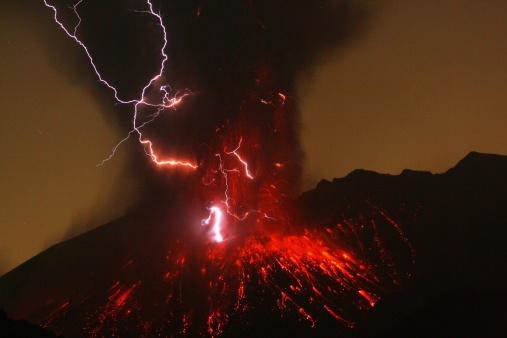Electrons Not the Cause of Charged Grains
Electrically charged grains or dust particles often produce lightning above volcanic eruptions and can sometimes ignite explosions in grain silos and coal mines. The most popular theory to explain the charging assumes that grains exchange electrons when they touch, but experiments reported in Physical Review Letters show that electrons are not the charges being transferred. The researchers measured charges and sizes of individual grains, in addition to the number of electrons available to transfer. They suggest that the charging may come from ions in water films on the grain surfaces. A clearer understanding of the charging mechanism could help prevent explosions as well as undesired clumping of powders in industrial settings.
Rubbing a balloon on your hair generates static electricity because charges can be pulled off of one object onto another. However, the identity of the charge carriers in this and other instances of “triboelectric” charging is still a matter of debate. When the rubbed objects are different metals, researchers have shown that electrons jump from one surface to the other. But the surface-jumping charges for insulators could be electrons, electron holes, ions, or nanosized chunks of material. “It has been very difficult to obtain experimental data of sufficient quality” to distinguish between models, says Heinrich Jaeger of the University of Chicago.
Jaeger and his colleagues were interested in the charging of insulating grains. Previous studies suggested that when grains of various sizes come into contact, the larger grains become positively charged, while the smaller grains become negative. One explanation for this size dependence is that grains contain electrons that are stuck in excited energy states [1]. A collision with another grain offers these “trapped electrons” an opportunity to hop into a lower energy state in the other grain. The assumption is that larger grains start off with more trapped electrons, so that on average they give away more of their electrons than they receive from the smaller grains.
The team was studying grains in free fall and realized that they could use their experimental apparatus to precisely measure the charge on grains and how it depends on size. For their grain material, the researchers chose zirconium dioxide silicate, which is known to support trapped electrons. With a mechanical sieve, they selected out grains with two distinct diameters: and micrometers. They mixed equal amounts of large and small grains in a hopper for about a half hour and then let them drop through an evacuated chamber with a uniform electric field pointing in the horizontal direction. A camera, also in free fall, recorded the motion of the grains in the electric field, allowing a determination of their charge. As expected, large grains had a positive charge, while small grains had a negative charge, with the magnitudes of both of these charges equivalent to about 2 million electrons.
If the trapped electron theory were correct, then each large grain should start off with at least 2 million more trapped electrons than the typical small grain. To check this prediction, the team turned to a technique used in archaeological dating called thermoluminescence. This method involves slowly heating a sample and recording the emitted glow. If trapped electrons are present, the heat energy helps them escape to a lower energy level and emit photons. The team’s thermoluminescence experiments showed no sign of any trapped electrons in the unmixed grains, from which they concluded that electrons are not involved in the charging process.
If not electrons, then another possibility is that grains are exchanging ions coming from water films that form on their surfaces, the team suggests. “Practically every surface has a monolayer of water on it,” says team member Scott Waitukaitis, now at the University of Leiden in the Netherlands. Recent work suggests that contact between two wetted surfaces causes negatively charged hydroxide ions (OH ) to be ripped from one surface and transferred to the other [2]. But how this happens is still unclear, Waitukaitis says.
“The authors show pretty clearly that there aren’t enough electrons trapped in high energy states to account for the observed charging,” says Daniel Lacks of Case Western Reserve University in Cleveland. But he is not surprised that the trapped electron model—which he helped develop—doesn’t apply to certain grains. “We have absolutely no idea what is happening with triboelectric charging and static electricity,” which is indeed surprising, he says, given how common they are in our lives.
–Michael Schirber
Michael Schirber is a Corresponding Editor for Physics Magazine based in Lyon, France.
References
- D. J. Lacks, N. Duff, and S. K. Kumar, “Nonequilibrium Accumulation of Surface Species and Triboelectric Charging in Single Component Particulate Systems,” Phys. Rev. Lett. 100, 188305 (2008)
- L. S. McCarty and G. M. Whitesides, “Electrostatic Charging Due to Separation of Ions at Interfaces: Contact Electrification of Ionic Electrets,” Angew. Chem., Int. Ed. 47, 2188 (2008)
- I. M. P. Houghton, K. L. Aplin, and K. A. Nicoll, “Triboelectric Charging of Volcanic Ash from the 2011 Grímsvötn Eruption,” Phys. Rev. Lett. 111, 118501 (2013)
More Information
Triboelectric Charging of Common Objects from the University of Rochester
Overview of static electricity from AlphaLab, Inc.





